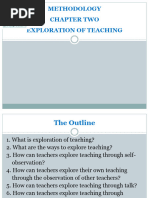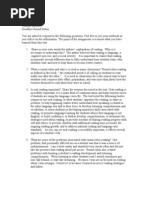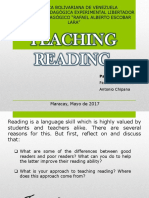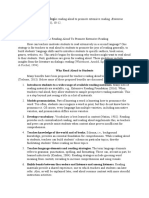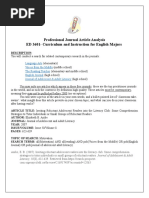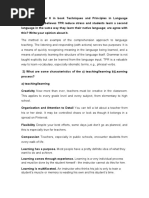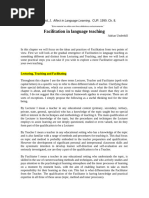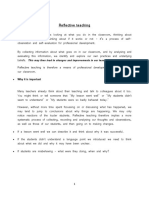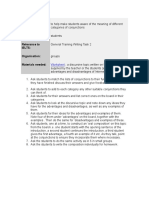0 ratings0% found this document useful (0 votes)
35 viewsSols Eltas Review
Sols Eltas Review
Uploaded by
Emily JamesThis book review summarizes the book "Spotlight On Learner Styles: Teacher Strategies For Learner Success" by Marjorie Rosenberg. The book provides an easy to understand overview of leading learning styles theories and provides lesson plans tailored to different styles. It examines how students take in, process, and react to information. The book also analyzes how teaching styles match or mismatch with learning styles and how to address mismatches. It recognizes limits to tailoring lessons but emphasizes the need for students to learn how to learn in new ways. The book is divided into three parts covering learning style theory, practical teaching activities, and additional approaches. It ends with numerous lesson plans that have been tested in practice. The reviewer recommends the
Copyright:
© All Rights Reserved
Available Formats
Download as PDF, TXT or read online from Scribd
Sols Eltas Review
Sols Eltas Review
Uploaded by
Emily James0 ratings0% found this document useful (0 votes)
35 views2 pagesThis book review summarizes the book "Spotlight On Learner Styles: Teacher Strategies For Learner Success" by Marjorie Rosenberg. The book provides an easy to understand overview of leading learning styles theories and provides lesson plans tailored to different styles. It examines how students take in, process, and react to information. The book also analyzes how teaching styles match or mismatch with learning styles and how to address mismatches. It recognizes limits to tailoring lessons but emphasizes the need for students to learn how to learn in new ways. The book is divided into three parts covering learning style theory, practical teaching activities, and additional approaches. It ends with numerous lesson plans that have been tested in practice. The reviewer recommends the
Original Description:
DELTA
Copyright
© © All Rights Reserved
Available Formats
PDF, TXT or read online from Scribd
Share this document
Did you find this document useful?
Is this content inappropriate?
This book review summarizes the book "Spotlight On Learner Styles: Teacher Strategies For Learner Success" by Marjorie Rosenberg. The book provides an easy to understand overview of leading learning styles theories and provides lesson plans tailored to different styles. It examines how students take in, process, and react to information. The book also analyzes how teaching styles match or mismatch with learning styles and how to address mismatches. It recognizes limits to tailoring lessons but emphasizes the need for students to learn how to learn in new ways. The book is divided into three parts covering learning style theory, practical teaching activities, and additional approaches. It ends with numerous lesson plans that have been tested in practice. The reviewer recommends the
Copyright:
© All Rights Reserved
Available Formats
Download as PDF, TXT or read online from Scribd
Download as pdf or txt
0 ratings0% found this document useful (0 votes)
35 views2 pagesSols Eltas Review
Sols Eltas Review
Uploaded by
Emily JamesThis book review summarizes the book "Spotlight On Learner Styles: Teacher Strategies For Learner Success" by Marjorie Rosenberg. The book provides an easy to understand overview of leading learning styles theories and provides lesson plans tailored to different styles. It examines how students take in, process, and react to information. The book also analyzes how teaching styles match or mismatch with learning styles and how to address mismatches. It recognizes limits to tailoring lessons but emphasizes the need for students to learn how to learn in new ways. The book is divided into three parts covering learning style theory, practical teaching activities, and additional approaches. It ends with numerous lesson plans that have been tested in practice. The reviewer recommends the
Copyright:
© All Rights Reserved
Available Formats
Download as PDF, TXT or read online from Scribd
Download as pdf or txt
You are on page 1of 2
ELTAS Ezine July 2013
Spotlight On Learner Styles:
Teacher Strategies For Learner Success
by Marjorie Rosenberg
Publisher: DELTA Publishing, England, ISBN: 9781905085712
Reviewed by:
Sebastian Turnbull, Training Materials Specialist
at Target Training GmbH
Let me start by saying that this is a really good book: its informative, practical and, at
times, inspiring.
Ms Rosenberg has summarised some of the leading theories on learning styles into
an easy-to-digest form and has provided lots and lots of mini-lesson plans for styleappropriate activities.
The approaches to learning styles that are looked at include:
how we take in information, that is:
perceptually: visual, auditory or kinaesthetic styles;
how we process information: globally or analytically;
and how we react to and deal with this information,
i.e. the Mind Organisation approach of April Bowie.
Whats particularly interesting is that these different models are used to analyse
teaching as well as learning styles. Possible mismatches between the two are
illustrated via classroom anecdotes, and the author looks at how possible conflicts
can be understood and overcome. Questionnaires and summary charts are given to
determine both your learners and your own learning style so that you can decide on
the appropriate approach to take.
The tenor taken when discussing these mismatches is reassuringly non-ideological.
The limits of lesson tailoring are recognised, especially with larger groups, and the
author is resolute that training is a two-way street. Teachers must certainly adapt to
learners, but learners must also learn how to learn, and this may involve extending
and adapting their own learning styles.
Layout
The book contains three distinctive parts which focus in turn on theory, practice and
development:
Part A explains the importance of our preferred learning styles.
Part B concentrates on activities we can employ to teach more comprehensively and
enable all our students to become successful learners.
Part C introduces further approaches, points to further activities beyond the purely
linguistic, and suggests further reading.
The book ends with a plethora of lesson plans, all of which will work in practice.
Theres nothing airy-fairy here, and I get the feeling that all this material has been
tested in the field and not just by the author.
All in all, this is one of the better books that Ive seen on the subject and a must-have
for any staffroom or training library.
You might also like
- Foundation Lesson The Three Levels of Reading PDFDocument12 pagesFoundation Lesson The Three Levels of Reading PDFapi-331273390100% (1)
- Exploring Second Language ReadingDocument4 pagesExploring Second Language ReadingLuis Rosique MartinezNo ratings yet
- Overcoming The Fear of Using Drama in English Language TeachingDocument15 pagesOvercoming The Fear of Using Drama in English Language TeachingEmily James100% (1)
- 1 Answer Key A Grammar, Vocabulary, and PronunciationDocument6 pages1 Answer Key A Grammar, Vocabulary, and PronunciationPatinéNo ratings yet
- PMC Module 6 Assignment (Sada Gul Roll#D12905)Document11 pagesPMC Module 6 Assignment (Sada Gul Roll#D12905)Muhammad Irfan Durrani73% (22)
- Objectives of A Reading ProgrammeDocument22 pagesObjectives of A Reading ProgrammeNur Ain Hasma 105351116517No ratings yet
- Project of TESOL Summary-PROGRAMMES AND PATTERNS OF WORKDocument7 pagesProject of TESOL Summary-PROGRAMMES AND PATTERNS OF WORKRijal QalbiNo ratings yet
- Read Journal Articles and Books About Teaching and Learning. Read Teacher Narratives. Attend Professional ConferencesDocument8 pagesRead Journal Articles and Books About Teaching and Learning. Read Teacher Narratives. Attend Professional Conferencesrnj4tbgyh5No ratings yet
- Author Insights Marjorie RosenbergDocument7 pagesAuthor Insights Marjorie RosenbergCarmen BugnarNo ratings yet
- Final Essay. TP-Cristina AmayaDocument7 pagesFinal Essay. TP-Cristina AmayaCMayacrucitaNo ratings yet
- 53 Interesting Things to Do in Your Lectures: Tips and Strategies for Really Effective Lectures and PresentationsFrom Everand53 Interesting Things to Do in Your Lectures: Tips and Strategies for Really Effective Lectures and PresentationsNo ratings yet
- Scrivener Teacher TypesDocument2 pagesScrivener Teacher TypesromaissaNo ratings yet
- Cognitive Load Theory: A handbook for teachersFrom EverandCognitive Load Theory: A handbook for teachersRating: 4 out of 5 stars4/5 (1)
- Exploration of TeachingDocument22 pagesExploration of Teachingali07711778443No ratings yet
- RICHARDS J C Beyond Training Perspectives On LanguDocument3 pagesRICHARDS J C Beyond Training Perspectives On LanguZarifa GuliyevaNo ratings yet
- R. L Allwright: What Do Lve Want Teaching Materials For?Document14 pagesR. L Allwright: What Do Lve Want Teaching Materials For?Olga Ichshenko100% (1)
- Factors Affecting The Choice of A TBDocument3 pagesFactors Affecting The Choice of A TBMed DjbaliNo ratings yet
- EFL in The Classroom-I (5661)Document17 pagesEFL in The Classroom-I (5661)Shaukat Hussain AfridiNo ratings yet
- What Do We Want Teaching Materials For AllwrightDocument14 pagesWhat Do We Want Teaching Materials For AllwrightnanioliNo ratings yet
- Author Insights Peter WatkinsDocument4 pagesAuthor Insights Peter WatkinsEmily JamesNo ratings yet
- Makalah WritingDocument13 pagesMakalah WritingNasrudin80% (5)
- What Is A Learner Centered ApproachDocument18 pagesWhat Is A Learner Centered ApproachSiva MuguntthanNo ratings yet
- Presenting New Language - TeachingEnglishDocument4 pagesPresenting New Language - TeachingEnglishfjv 45No ratings yet
- Tarea 4 Didáctica Especial Del InglésDocument8 pagesTarea 4 Didáctica Especial Del Inglésjos oviedoNo ratings yet
- Charles, Pecorari - 2015 - Intro and Chapter 1Document15 pagesCharles, Pecorari - 2015 - Intro and Chapter 1Nigora OlimovaNo ratings yet
- Chapter Three: Working With A Variety of ApproachesDocument17 pagesChapter Three: Working With A Variety of ApproachesId Tawheed KolajoNo ratings yet
- Teaching Philos-Wps OfficeDocument4 pagesTeaching Philos-Wps Officecanthought57No ratings yet
- Module 3Document24 pagesModule 3Jessalyn JimenezNo ratings yet
- Revised PLN Reflection and Top 5Document9 pagesRevised PLN Reflection and Top 5api-604279172No ratings yet
- Effective Writing1Document82 pagesEffective Writing1Ajitānanda DāsaNo ratings yet
- Work Smarter - Ten Ways To Improve Your TeachingDocument7 pagesWork Smarter - Ten Ways To Improve Your TeachingKenNo ratings yet
- Determining Your Teaching StyleDocument11 pagesDetermining Your Teaching StyleMeilana LolitasariNo ratings yet
- Book Review FormDocument4 pagesBook Review Formgalager13No ratings yet
- Goodbye Round RobinDocument3 pagesGoodbye Round RobinroylepayneNo ratings yet
- Richards Lockhart 2007Document28 pagesRichards Lockhart 2007rominafmerloNo ratings yet
- República Bolivariana de Venezuela Universidad Pedagógica Experimental Libertador Instituto Pedagógico "Rafael Alberto Escobar Lara"Document23 pagesRepública Bolivariana de Venezuela Universidad Pedagógica Experimental Libertador Instituto Pedagógico "Rafael Alberto Escobar Lara"patrocia19No ratings yet
- Dialogic Reading Aloud To Promote ExtensDocument6 pagesDialogic Reading Aloud To Promote ExtensshweyeehtooNo ratings yet
- Teaching: A Fresh Look at TeamDocument4 pagesTeaching: A Fresh Look at TeamPaula CNo ratings yet
- Article Analysis 2Document3 pagesArticle Analysis 2api-340960709No ratings yet
- Teaching Without A CoursebookDocument4 pagesTeaching Without A CoursebookLucasFernandesNo ratings yet
- Khairun Nisa CBR EYFLDocument4 pagesKhairun Nisa CBR EYFLRiski Triana putriNo ratings yet
- Teaching Methodology and Lesson PlanningDocument4 pagesTeaching Methodology and Lesson PlanningRosalina Rodríguez0% (1)
- Ppt Language Classroom ManagementDocument19 pagesPpt Language Classroom Managementpackrandy28No ratings yet
- Total Physical Reponse MethodDocument2 pagesTotal Physical Reponse MethodLarissa Altagracia NovaNo ratings yet
- Arnold. J. Affect in Language Learning. CUP. 1999. 8Document12 pagesArnold. J. Affect in Language Learning. CUP. 1999. 8Micaela Florencia MedinaNo ratings yet
- Cristina Amaya - Teaching PortfolioDocument13 pagesCristina Amaya - Teaching PortfolioCMayacrucitaNo ratings yet
- Teacher Induction Training: Synthesis Article: Module 4: Using Course BooksDocument10 pagesTeacher Induction Training: Synthesis Article: Module 4: Using Course BooksLílian MotaNo ratings yet
- Elt Textbooks Evaluation and Adaptation: Lingjuan MaDocument7 pagesElt Textbooks Evaluation and Adaptation: Lingjuan Mayuri231No ratings yet
- Techniques and Principles in Language Teaching 2Document3 pagesTechniques and Principles in Language Teaching 2api-322718808No ratings yet
- 5 StraightforwardDocument10 pages5 Straightforwardapi-264101017100% (1)
- Observation 3 (Patterns of Interaction) - M. PerezDocument3 pagesObservation 3 (Patterns of Interaction) - M. Perezmeyperez100% (1)
- Arnold. J. Affect in Language Learning. CUP. 1999. 8Document12 pagesArnold. J. Affect in Language Learning. CUP. 1999. 8Marilina FernandezNo ratings yet
- Curriculum and Material Development Resensi Buku: Muhammad Thahir M. 11B01168 Kelas EDocument5 pagesCurriculum and Material Development Resensi Buku: Muhammad Thahir M. 11B01168 Kelas EDwi FanyNo ratings yet
- Teach Like Nobody's Watching: The essential guide to effective and efficient teachingFrom EverandTeach Like Nobody's Watching: The essential guide to effective and efficient teachingNo ratings yet
- Orem2001 Journal Writing in ESLDocument10 pagesOrem2001 Journal Writing in ESLmadanushoNo ratings yet
- Cooperative Learning and Teaching, Second EditionFrom EverandCooperative Learning and Teaching, Second EditionRating: 5 out of 5 stars5/5 (1)
- Chapter One The Self-Developed Language Teacher: Comparison Between Yoshi's and Kathy's TeachingDocument8 pagesChapter One The Self-Developed Language Teacher: Comparison Between Yoshi's and Kathy's TeachingMuhammed Teymur KopruluNo ratings yet
- Coursebook Evaluation CunningsworthDocument8 pagesCoursebook Evaluation CunningsworthLia Dufresne LiasNo ratings yet
- Reflective TeachingDocument6 pagesReflective TeachingA A SalmanNo ratings yet
- Do Thuy Hong - Mid-TermDocument8 pagesDo Thuy Hong - Mid-TermĐỗ Thúy HồngNo ratings yet
- What Is Linguistic ModeDocument13 pagesWhat Is Linguistic Modeosakihanna7No ratings yet
- Roles of Teachers and Learners. Oxford: Oxford University Press, 1987. (164 PP.)Document2 pagesRoles of Teachers and Learners. Oxford: Oxford University Press, 1987. (164 PP.)UmerBukhariNo ratings yet
- Delta LBA 2 - Language Skills 14th October 2005: Motivational Factors in Developing Reading SkillsDocument14 pagesDelta LBA 2 - Language Skills 14th October 2005: Motivational Factors in Developing Reading SkillsEmily James100% (2)
- Assignment 4Document9 pagesAssignment 4Emily James100% (1)
- By Emma Worrall - Lesson Plan - The Procedure: Stage 1Document2 pagesBy Emma Worrall - Lesson Plan - The Procedure: Stage 1Emily JamesNo ratings yet
- Lba 3Document16 pagesLba 3Emily James0% (1)
- Main Aims: To Produce A Cohesive Written TextDocument2 pagesMain Aims: To Produce A Cohesive Written TextEmily JamesNo ratings yet
- DiscourseDocument7 pagesDiscourseEmily James100% (1)
- Coherence InsettDocument18 pagesCoherence InsettEmily JamesNo ratings yet
- Lesson Plan Procedure PA7Document2 pagesLesson Plan Procedure PA7Emily JamesNo ratings yet
- New Ass 2Document14 pagesNew Ass 2Emily JamesNo ratings yet
- Helping Low - Level Learners Use Bottom-Up Processing Strategies To Understand Reading TextsDocument12 pagesHelping Low - Level Learners Use Bottom-Up Processing Strategies To Understand Reading TextsEmily JamesNo ratings yet
- Commentary - LBA2Document2 pagesCommentary - LBA2Emily JamesNo ratings yet
- EvaluationDocument2 pagesEvaluationEmily JamesNo ratings yet
- Kkirichenko Corrected Pda Ra Stage3Document24 pagesKkirichenko Corrected Pda Ra Stage3Emily JamesNo ratings yet
- T - B L T: ASK Ased Anguage EachingDocument15 pagesT - B L T: ASK Ased Anguage EachingEmily JamesNo ratings yet
- Language Systems Assignment 4 - Lexis: Helping Lower-Level Learners Understand and Use Phrasal VerbsDocument10 pagesLanguage Systems Assignment 4 - Lexis: Helping Lower-Level Learners Understand and Use Phrasal VerbsEmily JamesNo ratings yet
- Teaching Phrasal Verbs To Lower LearnersDocument14 pagesTeaching Phrasal Verbs To Lower LearnersIsrael BenavidesNo ratings yet
- Language Systems Assessment 2: Skills: Helping Learners Write Semi-Formal EmailsDocument13 pagesLanguage Systems Assessment 2: Skills: Helping Learners Write Semi-Formal EmailsEmily JamesNo ratings yet
- Reflection and Action: Stage 2Document11 pagesReflection and Action: Stage 2Emily JamesNo ratings yet
- Kkirichenko Lsa1 Be DraftDocument12 pagesKkirichenko Lsa1 Be DraftEmily JamesNo ratings yet
- Lesson Aim:: Commented (S1) : How Does This Sound? I'm Not Sure AboutDocument3 pagesLesson Aim:: Commented (S1) : How Does This Sound? I'm Not Sure AboutEmily JamesNo ratings yet
- Kkirichenko Lsa3 ReDocument2 pagesKkirichenko Lsa3 ReEmily JamesNo ratings yet
- Lesson Plan: Main Aims and Learning OutcomesDocument3 pagesLesson Plan: Main Aims and Learning OutcomesEmily JamesNo ratings yet
- Helping Low - Level Learners Use Bottom-Up Processing Strategies To Understand Reading TextsDocument12 pagesHelping Low - Level Learners Use Bottom-Up Processing Strategies To Understand Reading TextsEmily JamesNo ratings yet
- Kkirichenko Extass ProposalDocument2 pagesKkirichenko Extass ProposalEmily JamesNo ratings yet
- Kkirichenko Lsa1 Be FinalDocument12 pagesKkirichenko Lsa1 Be FinalEmily JamesNo ratings yet
- Lesson Commentary:: NB: I Will Try To Make It More Specific Group-Oriented When I Get To Know The StudentsDocument9 pagesLesson Commentary:: NB: I Will Try To Make It More Specific Group-Oriented When I Get To Know The StudentsEmily JamesNo ratings yet
- Language Systems Assessment 2: Skills: Helping Learners Write Semi-Formal EmailsDocument8 pagesLanguage Systems Assessment 2: Skills: Helping Learners Write Semi-Formal EmailsEmily JamesNo ratings yet
- Extended Assignment: Teaching English To Young LearnersDocument8 pagesExtended Assignment: Teaching English To Young LearnersEmily JamesNo ratings yet
- T - B L T: ASK Ased Anguage EachingDocument15 pagesT - B L T: ASK Ased Anguage EachingEmily James100% (1)
- Writers Effects ChecklistDocument2 pagesWriters Effects ChecklistAnesu Mutyebere100% (1)
- Semántica de La Lengua InglesaDocument16 pagesSemántica de La Lengua InglesaNayla MartinezNo ratings yet
- New Destinations b1 Teacher S Book PDF Downloads FreeDocument4 pagesNew Destinations b1 Teacher S Book PDF Downloads FreeЕльнара Насірова0% (1)
- Mia Aguilar - INGLES - P4 - WS - Health Matters - MIA AGUILARDocument2 pagesMia Aguilar - INGLES - P4 - WS - Health Matters - MIA AGUILARHector ReuterNo ratings yet
- 4 5895601813654079927 PDFDocument249 pages4 5895601813654079927 PDFqabsNo ratings yet
- Writing ActivitiesDocument20 pagesWriting ActivitiesMiyYen100% (1)
- Applied Linguistics - SummaryDocument7 pagesApplied Linguistics - SummaryTharanga Hewage90% (10)
- Anonymous - 50 of The Most Powerful Spells On The Face of Earth Cd2 Id1044029255 Size471Document3 pagesAnonymous - 50 of The Most Powerful Spells On The Face of Earth Cd2 Id1044029255 Size471Pedro CM100% (2)
- Hiligaynon - Surallah: A Field Work On Language Variations SociolinguisticsDocument7 pagesHiligaynon - Surallah: A Field Work On Language Variations SociolinguisticsLyanca RemultaNo ratings yet
- Personal Information Name/Surname: Pauline Dallena LucanaDocument3 pagesPersonal Information Name/Surname: Pauline Dallena LucanaPauline Dallena LucanaNo ratings yet
- Arabic Expressions You've Definitely Heard (But Probably Don't Know The Meaning Of)Document3 pagesArabic Expressions You've Definitely Heard (But Probably Don't Know The Meaning Of)Zsa ChuNo ratings yet
- 2bi Plan Week 8Document2 pages2bi Plan Week 8johnnyNo ratings yet
- تحليل الخطاب من مدخل سوسيولوجيا المعرفة - المرتكزات واستراتيجية التحليلDocument17 pagesتحليل الخطاب من مدخل سوسيولوجيا المعرفة - المرتكزات واستراتيجية التحليلAicha BenchakrouneNo ratings yet
- Press: Overview of Reading ComprehensionDocument13 pagesPress: Overview of Reading ComprehensionIrizh DanielleNo ratings yet
- Test For Pre-Intermediate StudentsDocument2 pagesTest For Pre-Intermediate StudentsPatricia Baldonedo100% (1)
- Developing Students' Vocabulary Range For Describing People by Gerard EleyDocument6 pagesDeveloping Students' Vocabulary Range For Describing People by Gerard EleyNicoletaMuresanNo ratings yet
- 10.verbal and Non Verbal Communication-1Document7 pages10.verbal and Non Verbal Communication-1Benson HansonNo ratings yet
- First Conditional Card GameDocument20 pagesFirst Conditional Card Gamedelmiza putriNo ratings yet
- The Eagle Lesson PlanDocument33 pagesThe Eagle Lesson PlanJohn Perseus Lee0% (1)
- Easy English Grammar TensesDocument129 pagesEasy English Grammar TensesVusala HasanovaNo ratings yet
- Natural Language Processing - Semantic Aspects PDFDocument343 pagesNatural Language Processing - Semantic Aspects PDFAlbert Butan100% (3)
- 415 536 1 SM PDFDocument9 pages415 536 1 SM PDFTorres Ken Robin DeldaNo ratings yet
- Barbera Barth 5.1Document33 pagesBarbera Barth 5.1Rog DonNo ratings yet
- The Nirukta of YaskaDocument542 pagesThe Nirukta of YaskaTina BhatNo ratings yet
- 3-4 Eye of The StormDocument81 pages3-4 Eye of The StormGerardo ValladaresNo ratings yet
- Baur, F. - A Philological Introduction To Greek and Latin For Students (1883)Document220 pagesBaur, F. - A Philological Introduction To Greek and Latin For Students (1883)Verónica Díaz Pereyro100% (1)
- Academic Writing and Critical Analysis: Studying in Higher EducationDocument4 pagesAcademic Writing and Critical Analysis: Studying in Higher EducationStanley IheukoNo ratings yet














